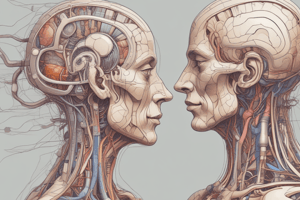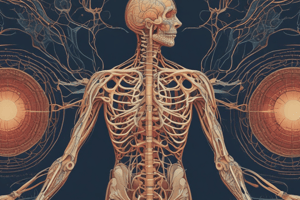Podcast
Questions and Answers
What is the definition of anatomy?
What is the definition of anatomy?
The study of the body's structure by dissecting or cutting apart the parts of the body for study.
What does neurophysiology study?
What does neurophysiology study?
Disorders affecting the brain and the nerve and muscle functions.
What are some subcategories of anatomy?
What are some subcategories of anatomy?
- Regional Anatomy
- Systemic Anatomy
- Histology
- All of the above (correct)
True or False: Meningitis and encephalitis are non-inflammatory diseases.
True or False: Meningitis and encephalitis are non-inflammatory diseases.
What is myasthenia gravis?
What is myasthenia gravis?
What is the leading cause of death globally?
What is the leading cause of death globally?
What percentage of CVD deaths were due to heart attack and stroke in 2019?
What percentage of CVD deaths were due to heart attack and stroke in 2019?
What is renal physiology?
What is renal physiology?
What is the definition of anatomy?
What is the definition of anatomy?
What is the difference between gross anatomy and microscopic anatomy?
What is the difference between gross anatomy and microscopic anatomy?
Physiology is concerned with the study of functions of living things.
Physiology is concerned with the study of functions of living things.
What condition is characterized by the communication breakdown between nerves and muscles?
What condition is characterized by the communication breakdown between nerves and muscles?
Which of the following are considered categories of physiology? (Select all that apply)
Which of the following are considered categories of physiology? (Select all that apply)
What are cardiovascular diseases (CVDs) considered to be?
What are cardiovascular diseases (CVDs) considered to be?
Meningitis and encephalitis are caused by bacterial or viral infections.
Meningitis and encephalitis are caused by bacterial or viral infections.
What percentage of global deaths in 2019 were estimated to be caused by CVDs?
What percentage of global deaths in 2019 were estimated to be caused by CVDs?
Flashcards are hidden until you start studying
Study Notes
Anatomy and Physiology Overview
- Anatomy: Scientific discipline focused on dissecting and studying the body's structure.
- Gross Anatomy: Examines large structures visible to the naked eye.
- Microscopic Anatomy: Investigates smaller structures using microscopes.
- Physiology: The science of body functions, exploring how anatomical structures work together.
- Essential for understanding the body's processes and the interplay of chemistry and physics.
Subcategories of Anatomy
- Regional Anatomy: Studies specific areas of the body.
- Systemic Anatomy: Focuses on organ systems.
- Histology: Microscopic study of tissues.
- Cytology: Study of individual cells.
Neurophysiology
- Investigates disorders affecting the brain and nervous system.
- Common Disorders:
- Meningitis: Inflammation of brain and spinal cord membranes.
- Strokes: Occur due to blood flow issues; critical for timely intervention to avoid substantial damage.
- Dementia: Affects memory and cognitive functions.
- Encephalitis: Inflammation due to viral or bacterial infections.
- Myasthenia Gravis: Muscle weakness and fatigue caused by impaired nerve-to-muscle communication.
- Common Disorders:
Myasthenia Gravis
- Characterized by muscle weakness, especially in voluntary muscles.
- Symptoms include double vision, drooping eyelids, and difficulties in speaking, chewing, and breathing.
- More common in women under 40 and men over 60.
- No cure exists, but treatments can alleviate symptoms.
Cardiovascular Diseases (CVDs)
- Leading global cause of death, accounting for approximately 32% of fatalities.
- In 2019, around 17.9 million deaths were attributed to CVDs, primarily from heart attacks and strokes (85%).
- Over 75% of CVD-related deaths occur in low- and middle-income countries.
Renal Physiology
- Focuses on the renal system, which includes the kidneys, ureters, and urethra.
- Plays a critical role in maintaining homeostasis, including the regulation of fluids, electrolytes, and waste elimination.
Anatomy and Physiology Overview
- Anatomy: Scientific discipline focused on dissecting and studying the body's structure.
- Gross Anatomy: Examines large structures visible to the naked eye.
- Microscopic Anatomy: Investigates smaller structures using microscopes.
- Physiology: The science of body functions, exploring how anatomical structures work together.
- Essential for understanding the body's processes and the interplay of chemistry and physics.
Subcategories of Anatomy
- Regional Anatomy: Studies specific areas of the body.
- Systemic Anatomy: Focuses on organ systems.
- Histology: Microscopic study of tissues.
- Cytology: Study of individual cells.
Neurophysiology
- Investigates disorders affecting the brain and nervous system.
- Common Disorders:
- Meningitis: Inflammation of brain and spinal cord membranes.
- Strokes: Occur due to blood flow issues; critical for timely intervention to avoid substantial damage.
- Dementia: Affects memory and cognitive functions.
- Encephalitis: Inflammation due to viral or bacterial infections.
- Myasthenia Gravis: Muscle weakness and fatigue caused by impaired nerve-to-muscle communication.
- Common Disorders:
Myasthenia Gravis
- Characterized by muscle weakness, especially in voluntary muscles.
- Symptoms include double vision, drooping eyelids, and difficulties in speaking, chewing, and breathing.
- More common in women under 40 and men over 60.
- No cure exists, but treatments can alleviate symptoms.
Cardiovascular Diseases (CVDs)
- Leading global cause of death, accounting for approximately 32% of fatalities.
- In 2019, around 17.9 million deaths were attributed to CVDs, primarily from heart attacks and strokes (85%).
- Over 75% of CVD-related deaths occur in low- and middle-income countries.
Renal Physiology
- Focuses on the renal system, which includes the kidneys, ureters, and urethra.
- Plays a critical role in maintaining homeostasis, including the regulation of fluids, electrolytes, and waste elimination.
Studying That Suits You
Use AI to generate personalized quizzes and flashcards to suit your learning preferences.




